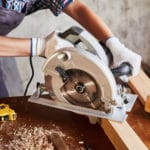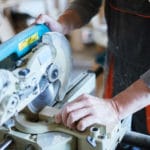What’s the difference between a jigsaw and a reciprocating saw? They both have blades to cut through wood, metal, plastic, drywall, etc. But there are some key differences that you should know about before making your purchase decision.
In this article, we’ll discuss these differences as well as which one might be better for your project.
What is a Jigsaw?
A jigsaw is a power saw that cuts by pushing its metal teeth-like blade through the material to be cut. Jigsaws come in many shapes and sizes, from those designed for cutting curves or those with especially long blades for cutting large and wide boards.
If you’re only going to use the saw once and don’t mind spending more money on it, you should buy a jigsaw that’s easy to use and that has few moving parts so that there’s less to go wrong.
A jigsaw is a hand-held power saw that functions with an electric motor. It has a thin blade that’s shaped like a segment of a circle. It is primarily used to cut curved shapes in wood, plastic, and drywall. This saw has an angled blade with sharp teeth on one edge which is repositionable by adjusting the rivets.
It also has a small shield that protects the hands from the teeth when making adjustments or handling delicate materials like plastics or drywall.
What is a Jigsaw Best For?
A jigsaw is a type of saw that has a long, thin blade that resembles a sawtooth pattern. This blade spins as you push your saw up and down over the material you’re cutting through. Jigsaws are more useful for intricate cuts that require precision, but they also have a lot of torque to cut tough materials like metal and wood.
You can choose from different types of blades depending on your use case: carbide tipped (general purpose), high-speed steel (intermittent cutting), ceramic (fine finish with less heat emission), and tungsten carbide (high-pressure applications with a need for sharp teeth).
How Do You Maintain a Jigsaw?
First, you want to check the blade for any loose debris or pieces of metal which can damage the jigsaw. Be sure to remove all of the pieces before you start cutting.
Once everything has been cleared, hold the saw by its outer edge and then pivot it back and forth a few times to clear out any dust from inside. This will keep it running smoother and last longer.
It’s also important to know how to store your jigsaw after use, as they can become damaged if not properly stored. It is best to store it in a dry place like a garage or basement with no moisture or ventilation issues. You don’t want anything causing your saw blades to rust up and become useless.
What is a Reciprocating Saw?
A reciprocating saw (also called a Sawzall) is the generic name for a type of power tool used to cut through materials like wood, metal, and plastic. It consists of one or more blades on an oscillating spindle that allows it to make cuts by either pushing them forward with each stroke or pulling them backward using the weight of the tool.
It has a long blade that can be moved in both directions. This allows it to cut at any angle and make straight cuts through metal beams along with other materials like wood or plastics.
The reciprocating saw will have a variable speed trigger allowing you to vary the cutting speed depending on what material you are working with and how much pressure is required.
What is a Reciprocating Saw Best For?
A reciprocating saw is a power tool with a toothed blade that rotates on a horizontal axis. It’s often used to cut through material that has been milled or cut on the side, such as metal pipes.
It features a handle, trigger, and blade clamp. The blade moves back and forth in an up-and-down motion. It has the advantage of being able to cut through many different materials, including metal studs, steel bars, aluminum pipes, PVC pipe, wood flooring, drywall, plasterboard on the wall.
A reciprocating saw is most often used for woodworking or heavy-duty metal cutting. It is best for more heavy-duty jobs and can be used with a variety of blades, depending on the material you’re cutting through.
How Do You Maintain a Reciprocating Saw?
When using a reciprocating saw, it is important to keep the blade tensioned and clean. This will not only extend the life of the blade but also make the blade more effective. A reciprocating saw should be cleaned after each use and before storage.
When cleaning, remove large pieces of debris such as metal scraps by scraping them off with a screwdriver or similar tool. It is also important to use a lubricant to periodically oil the saw’s blade. This will help to prevent the blade from rusting.
If you do not have time to clean and lubricate your saw, at least take a few minutes to thoroughly wipe off debris before putting it away for storage so that moisture does not build up in the tool or on its blades.
Jigsaw vs Reciprocating Saw: Which Should You Use?
In most cases, you should probably use a jigsaw for your woodworking project unless it’s something like a large room.
The name “reciprocating” comes from the back and forth motion of the saw blade as you cut through your material, which is different than a jigsaw where it moves up and down (back & forth) with each stroke.
The jigsaw will give you more control than a reciprocating saw because it has lower vibration and less blade exposure. Also, since they are designed for cutting curves, this type of power tool is much better at making angles cuts in wood or sheet metal.
The jigsaw can also get into spaces that are difficult to reach with other tools, making it a good choice for doing detailed work.
Whereas the reciprocating saw can cut faster and easier through materials that are difficult to cut because of their hardness or thickness.
The reciprocating saw also has a larger range of blade sizes and types that can be used, whereas the jigsaw generally only uses one size.
Conclusion
At the end of this article, you should have a better understanding of what the differences are between these two types of saws. You’ll be able to decide which one is best for your project and budget.
This decision will depend on factors like whether or not you need more control over how much power goes into each cut, if you want something lightweight that can get in tight spaces, etc.
Which type do you think would be better suited for your project? Let us know in the comments below!




